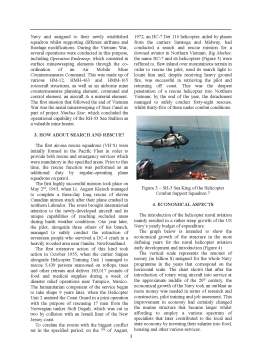Extras din referat
Abstract:
The development of operational rotorcraft amongst naval procedures has certainly grown in the past decades, allowing a whole new set of concepts and capabilities to be born and performed during both civilian and military actions. Due to the fact that achieving a fully operational status regarding the helicopter-warship hybrid has become an emergent idea since the interwar period, governments worldwide began to invest in means of rotorcraft construction as a highly potent weapon against naval threats. This study aims to bring up the progress made in the above specified field’s earlys stages while focusing on the technological evolution, the expansion of the whole mission spectrum and the historical key-points and figures who made the desire to fly over the sea completely achievable. The paper will exhibit the way in which the embarked helicopter was used to lessen the hardships of achieving economic growth, functional health services and airspace security over the sea, whilst remaining a highly reliable and efficient airship.
Keywords : helicopter, navy, development, warship.
1. INTRODUCTION
Since 1912, when the US Secretary of Naval Forces allocated a 50-dollar budget of research for the development of a range of constructive models for helicopters, the conception of utility for this type of aircraft began to get in shape with slow, but steady steps. About 19 years later, more specifically in September 1931, US Navy Lieutenant Alfred M. Pride marks the first successful take-off of a rotary-wing aircraft from a warship whilst also managing to land without incidents aboard aircraft carrier USS Langley.
Acknowledging the possible utility in helicopter use during maritime actions and operations, the US government had suplimented the research funds, attracting the most capable minds of the aeronautics industry in a race for developing the first fully operational helicopter. After a series of failed trials and experiments, the man that caught up with the government’s expectations had showed up in the person of Ukrainian engineer Igor Sikorsy and its VS-300 aircraft (Figure 1), which was successfully flown on May 24, 1940. The helicopter included the classic main rotor-tail rotor configuration, with a three-bladed portant rotor which was responsible for thrust and a tail rotor which dealed with the anti-torque effect. The fuselage was built of steel and aluminium, and the early-model cockpit was covered in a special cloth in order to ensure the fact that the whole construction was light enough to lift off the ground or the carrier deck. The pilot’s perspective was similar of that on an airplane.
Figure 1 - Vought-Sikorsky VS300
With the construction of this prototype, Sikorsky manages to set a standard for further constructive solutions while demonstrating the concept’s plausibility in the project financers’s eyes.
On the 16th of October 1943, LCDR Erickson marks the naval aviation birthday through his flight with the Sikorsky YR-4B, which eventually becomes the first commisioned rotorcraft prototype. One month later, the above-mentioned pilot was promoted to the CDR rank and took the command of the first naval aviation training school, established in the air wing of the NY coast guard base.
Two years later, the whole constructive solution spectrum began to develop with the introduction of the Piasecki XHRP-X concept, which is the father of the nowadays CH-47 Chinook. Tandem rotors were believed to improve the engine’s utility by reducing the power-absorbing rate up to 30% created by the introduction of a classic tail rotor.
Another modification to the original concept was brought up by the HO3S-1 helicopter, which was equipped with folding blades that generated a considerable amount of storage space economy on the deck. The technological advance grew to a level that started to imply doctrine changes; the use of the rotary wing aircraft in early hybrid-war operations was concluded by the beginning of various operative excersises which aimed at transporting the sea-based troops on land whilst focusing on the logistics aspect of the matter by ensuring that all their food provisions, equipment and ammunition were also carried aboard.
Bibliografie
[1].http://www.nhahistoricalsociety.org/index.php/naval-helicopter-history-timeline-new/
[2].https://www.history.navy.mil/research/library/online-reading-room/title-list-alphabetically/b/budget-of-the-us-navy-1794-to-2004.html
[3].http://www.militarytoday.com/helicopters/sh3_sea_king.htm
[4].https://disciplesofflight.com/gyrodyne-and-fairey-rotodyne/
[5].https://www.britannica.com/event/Vietnam-War
[6].Goodspeed, M. U.S Navy - A complete history, Naval Historical Foundation, 2003.
[7].Boyne, J. How the helicopter changed modern warfare, Pelican Publishing Company. 2011.
Preview document
Conținut arhivă zip
- The early use of US navy embarked helicopters.doc




